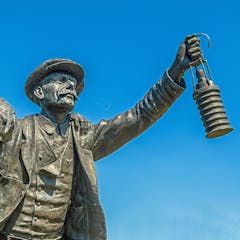
Articles on Disaster
Displaying 1 - 20 of 163 articles

A civil engineer lays out the physics behind Dali’s crash into the Francis Scott Key Bridge pier.

Human error may have contributed to the tragic accident in Baltimore harbour on March 26. Designing systems that reduce the potential for human error may help prevent future incidents.

The collapse of the Francis Scott Key bridge is already affecting global supply chains.

A cargo ship leaving the Port of Baltimore collided with a bridge in a technological disaster that may have claimed the lives of up to six maintenance workers on the bridge at the time.

We’ll need to learn the lessons from this disaster.

A civil engineer explains why ships taking out bridges is rare, and describes how bridge builders protect the structures from ship collisions.

Despite improvements in disaster response management since the Abbotsford floods of 2021, long-term animal welfare remains woefully underappreciated in B.C.

A hot, dry summer on the heels of a wet winter raises the risk of wildfires.

Governments and the media remain focused on responding to disasters, not preventing or preparing for them. Here’s what must change — and will and won’t work — as Canada faces increased disaster risks.

As Turkey is recovering from the most devastating earthquake in its recent history, a timely opportunity emerges to change how to reconstruct housing.

Tailoring crisis communications strategies across the phases of the disaster management cycle is a more successful approach and can help co-ordinate disaster responses.

The film asks how individuals and communities can tackle disaster while embracing an ethos of mutual aid that sidesteps yearning for nationalist policies that lead to even more harm.

As the climate warms, devastating fires are increasingly likely. The 2020 fires pushed the Southern Rockies beyond the historical average. Is there hope for the Northern Rockies?

Four hundred and forty men and boys were killed in the Senghenydd colliery disaster, with the youngest victims aged just 14 years old.

Focusing solely on humans at the expense of other life in the aftermath of train derailments limits the effectiveness of our disaster response management.

A deadly earthquake in Afghanistan, following one in Morocco, highlights the risks in the region.

Research shows gender-based violence increases in the aftermath of disasters. Governments must incorporate ways of addressing it into their disaster response plans.

As the mass evacuation of Yellowknife unfolds, the needs of minority populations will emerge. Past experiences indicate emergency officials may not be ready to meet the needs of a diverse population.

Maui officials have asked relatives to provide DNA samples to help identify victims of the Lahaina wildfires. Time and exposure to the elements, however, can make DNA retrieval from remains difficult.

Human exposure to wildfires in the US more than doubled in the past two decades. A climate scientist looks at who is at risk and why.
